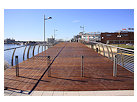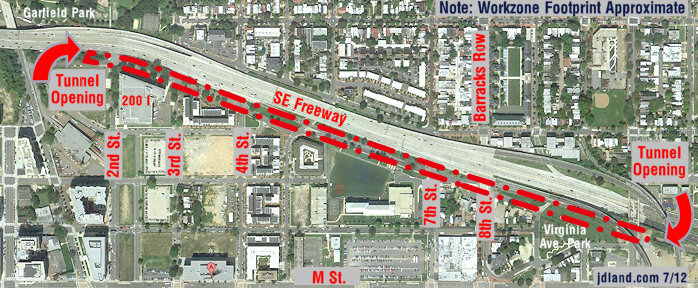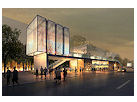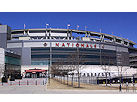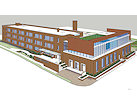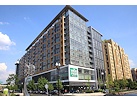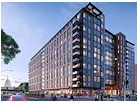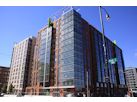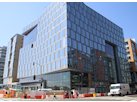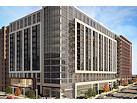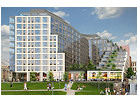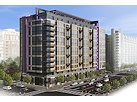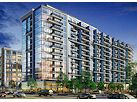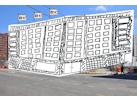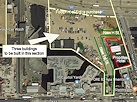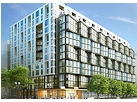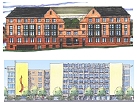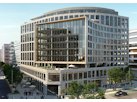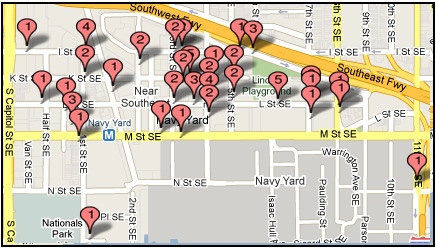|
| ||||||||||||||||||||
Please note that JDLand is no longer being updated.
peek >>
Near Southeast DC Past News Items
- Full Neighborhood Development MapThere's a lot more than just the projects listed here. See the complete map of completed, underway, and proposed projects all across the neighborhood.
- What's New This YearA quick look at what's arrived or been announced since the end of the 2018 baseball season.
- Food Options, Now and Coming SoonThere's now plenty of food options in the neighborhood. Click to see what's here, and what's coming.
- Anacostia RiverwalkA bridge between Teague and Yards Parks is part of the planned 20-mile Anacostia Riverwalk multi-use trail along the east and west banks of the Anacostia River.
- Virginia Ave. Tunnel ExpansionConstruction underway in 2015 to expand the 106-year-old tunnel to allow for a second track and double-height cars. Expected completion 2018.
- Rail and Bus Times
Get real time data for the Navy Yard subway, Circulator, Bikeshare, and bus lines, plus additional transit information. - Rail and Bus Times
Get real time data for the Navy Yard subway, Circulator, Bikeshare, and bus lines, plus additional transit information. - Canal ParkThree-block park on the site of the old Washington Canal. Construction begun in spring 2011, opened Nov. 16, 2012.
- Nationals Park21-acre site, 41,000-seat ballpark, construction begun May 2006, Opening Day March 30, 2008.
- Washington Navy YardHeadquarters of the Naval District Washington, established in 1799.
- Yards Park5.5-acre park on the banks of the Anacostia. First phase completed September 2010.
- Van Ness Elementary SchoolDC Public School, closed in 2006, but reopening in stages beginning in 2015.
- Agora/Whole Foods336-unit apartment building at 800 New Jersey Ave., SE. Construction begun June 2014, move-ins underway early 2018. Whole Foods expected to open in late 2018.
- New Douglass BridgeConstruction underway in early 2018 on the replacement for the current South Capitol Street Bridge. Completion expected in 2021.
- 1221 Van290-unit residential building with 26,000 sf retail. Underway late 2015, completed early 2018.
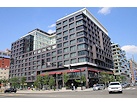
- NAB HQ/AvidianNew headquarters for National Association of Broadcasters, along with a 163-unit condo building. Construction underway early 2017.
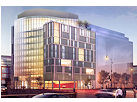
- Yards/Parcel O Residential ProjectsThe Bower, a 138-unit condo building by PN Hoffman, and The Guild, a 190-unit rental building by Forest City on the southeast corner of 4th and Tingey. Underway fall 2016, delivery 2018.
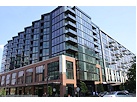
- New DC Water HQA wrap-around six-story addition to the existing O Street Pumping Station. Construction underway in 2016, with completion in 2018.
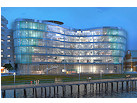
- The Harlow/Square 769N AptsMixed-income rental building with 176 units, including 36 public housing units. Underway early 2017, delivery 2019.
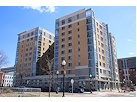
- West Half Residential420-unit project with 65,000 sf retail. Construction underway spring 2017.
- Novel South Capitol/2 I St.530ish-unit apartment building in two phases, on old McDonald's site. Construction underway early 2017, completed summer 2019.
- 1250 Half/Envy310 rental units at 1250, 123 condos at Envy, 60,000 square feet of retail. Underway spring 2017.
- Parc Riverside Phase II314ish-unit residential building at 1010 Half St., SE, by Toll Bros. Construction underway summer 2017.
- 99 M StreetA 224,000-square-foot office building by Skanska for the corner of 1st and M. Underway fall 2015, substantially complete summer 2018. Circa and an unnamed sibling restaurant announced tenants.
- The Garrett375-unit rental building at 2nd and I with 13,000 sq ft retail. Construction underway late fall 2017.
- Yards/The Estate Apts. and Thompson Hotel270-unit rental building and 227-room Thompson Hotel, with 20,000 sq ft retail total. Construction underway fall 2017.
- Meridian on First275-unit residential building, by Paradigm. Construction underway early 2018.
- The Maren/71 Potomac264-unit residential building with 12,500 sq ft retail, underway spring 2018. Phase 2 of RiverFront on the Anacostia development.
- DC Crossing/Square 696Block bought in 2016 by Tishman Speyer, with plans for 800 apartment units and 44,000 square feet of retail in two phases. Digging underway April 2018.
- One Hill South Phase 2300ish-unit unnamed sibling building at South Capitol and I. Work underway summer 2018.
- New DDOT HQ/250 MNew headquarters for the District Department of Transportation. Underway early 2019.
- 37 L Street Condos11-story, 74-unit condo building west of Half St. Underway early 2019.
- CSX East Residential/Hotel225ish-unit AC Marriott and two residential buildings planned. Digging underway late summer 2019.
- 1000 South Capitol Residential224-unit apartment building by Lerner. Underway fall 2019.
- Capper Seniors 2.0Reconstruction of the 160-unit building for low-income seniors that was destroyed by fire in 2018.
- Chemonics HQNew 285,000-sq-ft office building with 14,000 sq ft of retail. Expected delivery 2021.
2412 Blog Posts Since 2003
Go to Page: 1 | ... 24 | 25 | 26 | 27 | 28 | 29 | 30 | 31 | 32 ... 242
Search JDLand Blog Posts by Date or Category
Go to Page: 1 | ... 24 | 25 | 26 | 27 | 28 | 29 | 30 | 31 | 32 ... 242
Search JDLand Blog Posts by Date or Category
For your scheduling pleasure:
* Thursday's BID outdoor movie is Seabiscuit, the heartwarming tale of a horse swimming across the ocean for food (no, wait, that's not right). It starts at Canal Park at Second and M streets, SE, at 8:45 pm, but you can arrive early for some hula hooping with Hoop Jams at 8 pm. Rain cancellations will be posted on the BID web site by 4 pm.
* On Friday night (July 23) the Dave Matthews Band will be in concert at 7 pm at Nationals Park, with the Zac Brown Band opening. Tickets are still available, and the concert will go on rain or shine. (If you're heading to the ballpark for the concert and are unfamiliar with the territory, here's my Stadium Parking information page. But make it easy on yourself just take Metro.) Speaking of the stadium parking page, I've now added the new (tiny) $10 lot on the northwest corner of New Jersey and I.
* The rest of the weekend will be quiet (and hot), but then on Tuesday the 27th the Summer of Strasburg will return to the neighborhood, as Stephen is expected to pitch against the Atlanta Braves in a 7:05 pm game.
|
Comments (0)
|
 This week DDOT has started a series of parking pilot programs across the city, trying out different types of street parking payment systems to determine which technology and solutions work best for DC. The pilot chosen for some of the streets near Nationals Park is "ParkMobile," which allows you to pay for parking with your cellphone. Drivers sign up at the company's web site, and can download an iPhone or Blackberry app or use a mobile web site to pay for parking. (Hurry up with that Android app, wouldya?) Here's a map showing the streets in Near Southeast where the ParkMobile pilot is underway (basically all of M and the streets from the west side of Canal Park over to South Capitol, north of M). You'll receive a text message reminder when you've got about 15 minutes left of time. (And DDOT says that ParkMobile's transaction fees are being waived during the pilot.)
This week DDOT has started a series of parking pilot programs across the city, trying out different types of street parking payment systems to determine which technology and solutions work best for DC. The pilot chosen for some of the streets near Nationals Park is "ParkMobile," which allows you to pay for parking with your cellphone. Drivers sign up at the company's web site, and can download an iPhone or Blackberry app or use a mobile web site to pay for parking. (Hurry up with that Android app, wouldya?) Here's a map showing the streets in Near Southeast where the ParkMobile pilot is underway (basically all of M and the streets from the west side of Canal Park over to South Capitol, north of M). You'll receive a text message reminder when you've got about 15 minutes left of time. (And DDOT says that ParkMobile's transaction fees are being waived during the pilot.)Has anyone tried it out? If so, leave your experiences in the comments.
|
Comments (0)
More posts:
parking, Nationals Park
|
 WBJ updates its story from a few months ago to basically say, yes, DDOT is still planning to move to 55 M Street, Monument Realty's building on top of the west entrance of the Navy Yard station. The city council has until close of business today (Wednesday) to decide if it wants to hold up the plans, and apparently the council's budget office is taking a close look at the lease, since it will cost DDOT about $6.9 million per year over 10 years to consolidate all of its workers in Near Southeast, compared to the $3.1 million it's paying now to lease space in multiple buildings.
WBJ updates its story from a few months ago to basically say, yes, DDOT is still planning to move to 55 M Street, Monument Realty's building on top of the west entrance of the Navy Yard station. The city council has until close of business today (Wednesday) to decide if it wants to hold up the plans, and apparently the council's budget office is taking a close look at the lease, since it will cost DDOT about $6.9 million per year over 10 years to consolidate all of its workers in Near Southeast, compared to the $3.1 million it's paying now to lease space in multiple buildings.With USDOT just two blocks to the east, M Street SE would turn into Transportation Row if DDOT does indeed come to 55 M.
|
Comments (0)
|
The folks at CSX led a few local bloggers on a little tour late this afternoon along the footprint of the Virginia Avenue Tunnel, between New Jersey Avenue and 12th Street, SE, to give us a feel for the scope of the upcoming work to widen (and deepen) the tunnel to allow for double tracking and double-stacked railcars.  * If you stand on the bridge over the train tracks at New Jersey Avenue and look eastward toward the mouth of the tunnel at Second Street (seen at right), you can envision the beginning of the parallel track that will run first between the pillars of the SE Freeway, then in an open trench all the way to 12th Street while they're widening the existing tunnel. The new tunnel will expand four feet on either side of the current alignment, and the open trench will be dug on a line that extends about 19 feet south from the new wider footprint. They are working with the owner of the Charley Horse Stables just to the south of the train tracks to see how her operations can be handled during the estimated three-year construction time.
* If you stand on the bridge over the train tracks at New Jersey Avenue and look eastward toward the mouth of the tunnel at Second Street (seen at right), you can envision the beginning of the parallel track that will run first between the pillars of the SE Freeway, then in an open trench all the way to 12th Street while they're widening the existing tunnel. The new tunnel will expand four feet on either side of the current alignment, and the open trench will be dug on a line that extends about 19 feet south from the new wider footprint. They are working with the owner of the Charley Horse Stables just to the south of the train tracks to see how her operations can be handled during the estimated three-year construction time.
There isn't really any news to report--it wasn't a shock that there weren't any sudden outbursts of information about noise and dust abatement, traffic measures, access to the houses in the 300 block of Virginia Avenue, or anything along those lines, because CSX is holding all of its cards veeeeeeery close to its corporate vest until the NEPA process gets underway. They are expecting that their actual plans will go out for public comment sometime in the November-December timeframe, if all goes according to schedule. That said, here are a few items worth passing along (some of which I may have posted before but are worth repeating). But keep in mind that this is all still preliminary, the exact alignment won't be known until the design/build and NEPA process are completed, yadda yadda yadda.
 * If you stand on the bridge over the train tracks at New Jersey Avenue and look eastward toward the mouth of the tunnel at Second Street (seen at right), you can envision the beginning of the parallel track that will run first between the pillars of the SE Freeway, then in an open trench all the way to 12th Street while they're widening the existing tunnel. The new tunnel will expand four feet on either side of the current alignment, and the open trench will be dug on a line that extends about 19 feet south from the new wider footprint. They are working with the owner of the Charley Horse Stables just to the south of the train tracks to see how her operations can be handled during the estimated three-year construction time.
* If you stand on the bridge over the train tracks at New Jersey Avenue and look eastward toward the mouth of the tunnel at Second Street (seen at right), you can envision the beginning of the parallel track that will run first between the pillars of the SE Freeway, then in an open trench all the way to 12th Street while they're widening the existing tunnel. The new tunnel will expand four feet on either side of the current alignment, and the open trench will be dug on a line that extends about 19 feet south from the new wider footprint. They are working with the owner of the Charley Horse Stables just to the south of the train tracks to see how her operations can be handled during the estimated three-year construction time.* The temporary trench will run along the south side of Virginia Avenue on a line that will include most of the sidewalk and grass in front of 225 Virginia Avenue (right up to where the in-ground grates are, at which point the trench will shift northward toward the freeway somewhat). There will be coordination between CSX and StonebridgeCarras, who will be working on the reconstruction of 225 Virginia at the same time.
* Then, if you stand just south of the intersection at Fourth and Virginia and look west, there is a lamp post a few feet south of the stop sign in that spot--the edge of the trench will be about 9 feet south of that lamp post, which means the trench will be very close to the first house on Fourth, but gets farther from the houses in the 300 block as it goes west back to 225 Virginia. (I should have taken a picture. Oops.)
* At Fifth and Virginia, the off-ramp from the freeway will be shifted a couple feet northward--not that there's more than a few feet for it to move--so that it sits directly next to the embankment. Then, it looks like the Marines' fence along the 500 block of Virginia will have to be shifted about halfway down the hill from its current alignment, along with some of their HVAC equipment near Seventh Street.
* The work may require the closure of the on-ramp to the freeway at Eighth Street, requiring drivers to head to 11th and N to get on the 11th Street Bridges (at least until the new on-ramps are completed at 11th and M).
* At Ninth and Virginia, Dogma's property might not be clipped, but CSX will be working to help reorient Dogma's operations toward L Street (since the current access via Virginia Avenue will be unavailable). It's possible that L Street might temporarily become two-way during construction.
* The trench will come very close to the northern fence of the Virginia Avenue Garden, but they aren't sure yet of the exact final location.
* And if you've never seen the east end of the tunnel, east of 11th Street, here you go.
Of course, through all of this, all of Virginia Avenue will be closed to traffic, and the current sidewalks will be gone as well. There will be "bridges" across the tunnel and trench for vehicular and pedestrian traffic at Third, Fourth, Fifth, Seventh, and Eighth, and apparently pedestrian access will be maintained to the underpass at Second Street to get to Garfield Park.
But, as I said, the information residents most want to know isn't yet public, and I wouldn't expect hard news about the plans and mitigation measures until the NEPA process gets futher along. There will be a public comment period after a series of public meetings, though they are continuing to work with the city and the Feds behind the scenes. It will be interesting to see what comes to the table.
|
Comments (0)
More posts:
CSX/Virginia Ave. Tunnel
|
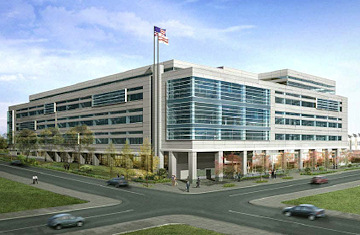 The city's Department of Real Estate Services (formerly OPM) has put out a solicitation to sublease 50,750 square feet of below-grade space at 225 Virginia Avenue as a data center. While that may be terribly interesting to some people, probably the item of greater interest is the rendering on the first page, which is the first glimpse of the "reskinned" building, showing the current gray windowless monolith rebuilt into a more open structure that actually resembles an office building. The rendering is from the building's southwest corner, so the SE Freeway (not shown) would run "behind" the building. You can just barely see Capitol Quarter townhouses at far right, making that Third Street.
The city's Department of Real Estate Services (formerly OPM) has put out a solicitation to sublease 50,750 square feet of below-grade space at 225 Virginia Avenue as a data center. While that may be terribly interesting to some people, probably the item of greater interest is the rendering on the first page, which is the first glimpse of the "reskinned" building, showing the current gray windowless monolith rebuilt into a more open structure that actually resembles an office building. The rendering is from the building's southwest corner, so the SE Freeway (not shown) would run "behind" the building. You can just barely see Capitol Quarter townhouses at far right, making that Third Street.The solicitation also says that construction is expected to begin in November of this year and last 15 months, with development being handled by StonebridgeCarras while the city continues to own the land. When completed, three city agencies will occupy the building--the Commission on Arts and Humanities, the Office of the Chief Technology Officer [hence the data center stuff], and the Child and Family Services Agency. If you see people wandering around the site on Tuesday, it's a site tour for parties interested in the data center colocation. Responses to the solicitation are due to the city on July 30.
If you're just joining the story now, feel free to read my past 225 Virginia posts to catch up on the many twists and turns this building has seen over the past few years. (h/t DCMud)
|
Comments (0)
|
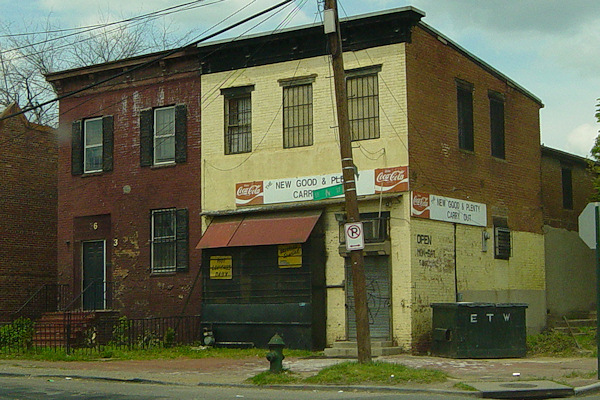 They say you never really know what's going on inside the walls of someone's home, and that certainly would have been the case if you had wandered by the northwest corner of Half and N in the early 1980s. The red brick rowhouse at 36 N Street, SE (seen at left in May 2003) would have looked unassuming enough to you, until you opened up your copy of the Washington Post on March 2, 1981, and read this:
They say you never really know what's going on inside the walls of someone's home, and that certainly would have been the case if you had wandered by the northwest corner of Half and N in the early 1980s. The red brick rowhouse at 36 N Street, SE (seen at left in May 2003) would have looked unassuming enough to you, until you opened up your copy of the Washington Post on March 2, 1981, and read this:"It was his first night at The Playground Swing Club in Southeast Washington, and the 37-year-old Army veteran was ready. He stripped and headed up the red-carpeted stairs to the lounge where a few men and women, most dressed only in robes, were sitting on cushioned floors and platforms. [...] Soon, he and a young woman he had never before met strolled into The Playroom, where bodies were lying in all directions on mattresses and a raised platform. He and the woman joined in. 'Everybody freeze!" a voice suddenly shouted. 'This is a raid!' "
 DC police had spent six weeks investigating The Playground, work which included having two undercover police couples "stripped to their underwear [who] spent three hours listening to the friendly discussions and watching the lovemaking." But when the bust happened in February of 1981, there were no charges of anyone paying for sex: the owner eventually was sentenced to 30 days in jail and fined $500 for operating a public hall without a license and failing to have a proper certificate of occupancy for the club. An additional charge of selling alcohol without a license was dropped.
DC police had spent six weeks investigating The Playground, work which included having two undercover police couples "stripped to their underwear [who] spent three hours listening to the friendly discussions and watching the lovemaking." But when the bust happened in February of 1981, there were no charges of anyone paying for sex: the owner eventually was sentenced to 30 days in jail and fined $500 for operating a public hall without a license and failing to have a proper certificate of occupancy for the club. An additional charge of selling alcohol without a license was dropped.A few of the "participants" at the house that night were charged under the city's sodomy laws, which brought swift condemnation from the ACLU: "Sexual conduct between consenting adults is none of the government's business." The raid also made for titillating reading in the Post, as the paper dryly explained the "swinging" culture: "What was happening at The Playground was a plain and simple orgy--an activity that seems to have become as common among a certain underground of adults as was dancing cheek-to-cheek in the 1930s."
The Playground was closed soon after, and a 1982 attempt to turn 36 N into an "erotica museum" was shot down by the city and neighbors. The rowhouse itself lasted until 2005, getting demolished two years before its neighbors met the wrecking ball as well. The site, now owned by Akridge as part of its Half Street footprint, is directly across from Nationals Park (which I guess you could also call a swinging establishment!), where the Bullpen now provides a different brand of entertainment during baseball season.
As for the Playground's owner? It was Dennis Sobin, longtime city activist and current mayoral candidate. A profile of Sobin earlier this year by the Georgetown Voice gives a quick summary of his years in Washington, including his ownership of multiple strip clubs, adult bookstores, and brothels in the late 70s, a third-place finish in the 1982 mayor's race, and a 10-year prison term in Florida on child pornography charges. He currently runs the Prisons Foundation, devoted to prison artists and their work.
(And no, I had no idea that this little item would end up tied to current city politics when I started!)
|
Comments (0)
|
The Little Red Building at Second and L, SE passed into history on Wednesday, but at least it will live on in my Demolished Buildings Gallery, as building #160 to meet its maker since I started taking photos in Near Southeast. Also added to the gallery today are the Anacostia Community Boathouse and its sister building, demolished earlier this month to make way for the 11th Street Bridges. If you haven't wandered through the gallery in a while, take a moment to watch the neighborhood's old life pass in front of your eyes.
|
Comments (0)
|
At Monday night's Zoning Commission meeting, the commissioners voted 3-0 after a brief discussion to approve a request by the DC Housing Authority and the Capper/Carrollsburg redevelopers to extend (again) the approved timeline for the long-planned Community Center at Fifth and K. The commissioners saw letters of support from both ANC 6B and 6D (you can see 6D's letter here), and seemed appeased by the notion that the $7-plus million required to build the center is figured into the $25 million that DCHA plans to eventually receive from a second bond offering (after the $29 million one late last year that's paying for infrastructure improvements), once the market improves.
In return for 6D's support for the time extension, the Housing Authority agreed to a number of conditions, mainly having to do with status reports and project updates, but also agreed (according to the letter) to "work with the ANC, D.C. Department of Parks and Recreation, and the Marine Corps to implement the agreement governing use of the Marine Corps' playing fields for the community." This is apparently a reaction to attempts to gain wider public access than is currently given to the fields at 7th and Virginia barracks as was originally agreed to when DCHA transferred that land to the Marines back in 1999.
The new time extension for the community center calls for building permit applications to be filed by July 1, 2012, with construction having to begin within 12 months of that date.
Via SWill's Twitter feed, it appears that American River Taxi may be closer to launching its initial service between Georgetown, the Southwest Waterfront, and Diamond Teague Park (next to Nationals Park). Their newly redesigned web site lists hours of operation (seven days a week), and a map shows the three initial stops along with future stops at National Airport, Alexandria, and National Harbor. No announcement as to when service will start, or what prices will be.
|
Comments (0)
More posts:
Teague Park, Water Taxis/Riverboats
|
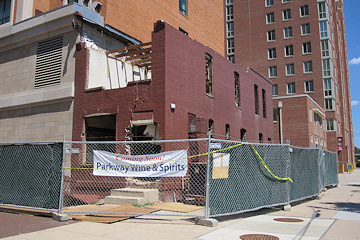 I can't imagine there's too many interested people who haven't yet seen this for themselves, so it's a bit more in the spirit of historical documentation that I've posted some images of what's left of the Little Red Building, now roofless and windowless and little more than a structure of [red] bricks, with a "Coming Soon! Parkway Wine and Spirits" sign hung on the fence.
I can't imagine there's too many interested people who haven't yet seen this for themselves, so it's a bit more in the spirit of historical documentation that I've posted some images of what's left of the Little Red Building, now roofless and windowless and little more than a structure of [red] bricks, with a "Coming Soon! Parkway Wine and Spirits" sign hung on the fence. And I'll remain sentimental about it, since it will always be a symbol to me of what Near Southeast was--and wasn't--when I first began venturing around with camera in hand nearly eight years ago. I've taken more than 200 photos of the northwest corner of Second and L since 2003 (see 60 or so of them here), but the first, seen at right, taken on Jan. 20, 2003, will always be my favorite.
And I'll remain sentimental about it, since it will always be a symbol to me of what Near Southeast was--and wasn't--when I first began venturing around with camera in hand nearly eight years ago. I've taken more than 200 photos of the northwest corner of Second and L since 2003 (see 60 or so of them here), but the first, seen at right, taken on Jan. 20, 2003, will always be my favorite.|
Comments (0)
More posts:
Little Red Bldg/Lot 38 Espresso
|
I'm still eyeing a couple more days of (mostly) blog-free living, but a few items should probably be mentioned before the weekend, and so that you don't think I'm never coming back. First, the calendar:
* On Monday at 6:30 pm, the Zoning Commission will take up the Housing Authority's new request for another time extension to the zoning order that requires construction of the Capper Community Center. DCHA had asked for a two-year extension last year, but was only granted one year, and made clear at that time that they didn't foresee having the money to start the center in that shorter time frame, and that they'd be back to ask for another extension. And now they are.
* Speaking of the community center, there's now a big sign on its footprint (at Fifth and L) touting that the second phase of Capitol Quarter's townhouses is being funded by the American Recovery and Reinvestment Act. But you knew that already.
* Monday at 7 pm is the monthly ANC 6D meeting. I was hoping the agenda would be out before I posted this, but alas, no. Check back here or on their web site to see what scintillating topics will be up for discussion. (UPDATE: the agenda is now out, and there's nothing really major on it, other than a public space permit for the street work for Phase 2 of Capitol Quarter.)
* On Tuesday, July 13, the Capitol Hill Group Ministry is having its "All-Star Party Night" at Nationals Park, offering the chance to take batting practice, throw pitches in the bullpen, tour the locker room, meet Teddy, and more. Tickets are $55 per person and $15 for children under 12, with proceeds going to CHGM's programs for homeless and low-income families.
And a few other items:
* Today's WBJ reports that a third piece of "public" art is coming to Nationals Park; this time it will be 30 "stainless steel-domed forms which will accurately follow the theoretical model of the trajectory of a curving fast-ball pitch," which will be hung early next year on the exterior of the eastern garage. The steel spheres with cutout "laces," each seven feet in diameter, will feature programmable LED lights; the piece will cost about $950,000. As for the other two pieces of public art already at the stadium (the bronze statues in the Center Field Plaza and the "Take Me Out to the Ballgame" mobile near the First Base Gate), I'll quote WBJ's Michael Neibauer: "The first two pieces of public art at the stadium were, to be kind, not well-received at their unveiling in April 2009. The works were selected by arts professionals and D.C. residents, according to the arts commission, but some wonder: Did anyone ask the fans?"
* A reader reports that the Anacostia Boathouse at 11th and O, in between the 11th Street Bridges spans, has been demolished, which was expected because of the footprint of the new bridges. Haven't seen for myself yet to confirm.
* And I haven't felt the earth shift on its axis yet, so I assume the Little Red Building's exterior is still standing, although interior demolition has been going on all week.
Without really intending it, the long holiday weekend combined with a dearth of neighborhood news and some stuff going on in real life is turning into a bit of a blogging break for me, and I've decided to extend it through the end of this week. If there's big news I'll pop back up, of course, but we're also now into the annual Summer Slowdown, so there probably won't be much to write about, anyway. (There might be a Tweet or two from me, as events warrant.)
You can use this post as an open thread to talk about anything Near Southeast-related that's on your mind.
In the meantime, here's a link to the Save Virginia Avenue Park video that was recently produced. And the latest BID newsletter.
|
Comments (0)
More posts:
JDLand stuff, Virginia Ave Park
|
Amazing to see one of these written when it's not right around Opening Day, but nonetheless, the Post's Bob McCartney writes in Thursday's Post about the stalled development plans in the neighborhood around Nationals Park, with a column titled "Development around Nats park isn't living up to its pitch." (Full disclosure: I helped him with some background on the neighborhood and various projects.)
Saying that he expects the Nats to have their first winning season before Near Southeast's renaissance is anywhere near complete, he frames the basic issue accurately: "The main obstacle is the same financial crisis that stalled the area's revival in the first place. Banks are still scared to lend money so that numerous large-scale construction plans can go forward." He hits the highlights--the opening of Justin's Cafe, the $23 million paid to the city this year from the various business and ballpark taxes, and the more than 3,000 residents that have arrived. But the usual low points are also hit, as he mentions the lack of progress on Half Street (both sides) and at the Florida Rock site.
There's no real news in the piece for anyone who's familiar with the area (or who stops by JDLand on a regular basis), but as these sorts of articles go, it's hard to quibble with.
|
Comments (0)
More posts:
Nationals Park
|
 I've gotten an update this evening on what is affectionately referred to around here as the "Little Red Building," the two-story townhouse on the eastern edge of the Courtyard by Marriott on L Street, SE. The owner has passed along the news that he has received his construction permits for a new two-story building that will house an upscale liquor store to be known as "Parkway Wine and Spirits." This does mean that the LRB is going to be demolished, and fences should go up tomorrow (Thursday) around the site. He expects the construction to take about five months, and since there will be some noise and disturbance while the work is underway, he wanted neighbors and residents to have advance notice.
I've gotten an update this evening on what is affectionately referred to around here as the "Little Red Building," the two-story townhouse on the eastern edge of the Courtyard by Marriott on L Street, SE. The owner has passed along the news that he has received his construction permits for a new two-story building that will house an upscale liquor store to be known as "Parkway Wine and Spirits." This does mean that the LRB is going to be demolished, and fences should go up tomorrow (Thursday) around the site. He expects the construction to take about five months, and since there will be some noise and disturbance while the work is underway, he wanted neighbors and residents to have advance notice. Here's the design plans for the exterior of the new building; hopefully we can also get some information on his operational plans (and what sort of goods he'll be stocking) soon. Looks like the new building will be brick as well, and of a similar design--I hope it'll still be red!
(And I have to admit that I'll be sorry to see it go, since it's the subject of one of my very first [and still one of my most favorite] photos.)
|
Comments (0)
|
Today WMATA sent out a press release touting a new web page highlighting its "dozens" of current and recently completed Transit Oriented development projects. And lo and behold, on the page for the Navy Yard "Chiller Plant" site on the southwest corner of Half and L, we find out that Metro has been negotiating a development agreement with Donatelli Development since the summer of 2008 (!) to build an 84-unit apartment building with ground-floor retail on the 14,000-square-foot site. Metro would continue to own the land and would receive lease income from the site, while Donatelli would be responsible for incorporating two new, larger, 350-ton chillers within the project (so that everyone down in both the Navy Yard and Waterfront-SEU Metro stations stay nice and climate-controlled).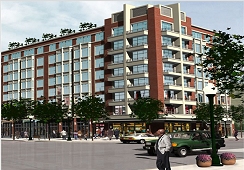 Metro says that this stalled development agreement is now "expected to be executed in the summer of 2010," with a lease between the companies to be signed about 18 months after that, once all development and construction permits are obtained. They say "late 2013" is when the project would open. At right is a rendering from the WMATA site of the proposed building. (Note that the footprint of this project does not include the cab company building just to the west at 37 L.)
Metro says that this stalled development agreement is now "expected to be executed in the summer of 2010," with a lease between the companies to be signed about 18 months after that, once all development and construction permits are obtained. They say "late 2013" is when the project would open. At right is a rendering from the WMATA site of the proposed building. (Note that the footprint of this project does not include the cab company building just to the west at 37 L.)
 Metro says that this stalled development agreement is now "expected to be executed in the summer of 2010," with a lease between the companies to be signed about 18 months after that, once all development and construction permits are obtained. They say "late 2013" is when the project would open. At right is a rendering from the WMATA site of the proposed building. (Note that the footprint of this project does not include the cab company building just to the west at 37 L.)
Metro says that this stalled development agreement is now "expected to be executed in the summer of 2010," with a lease between the companies to be signed about 18 months after that, once all development and construction permits are obtained. They say "late 2013" is when the project would open. At right is a rendering from the WMATA site of the proposed building. (Note that the footprint of this project does not include the cab company building just to the west at 37 L.)(And yes, I'm hanging my head in shame for not knowing about this. I knew that Metro was negotiating with *someone*, but had never heard who, and figured it fell through as time passed with no announcement. Maybe I'll take all of August off as punishment.)
|
Comments (0)
|
A few bullets for a warm Monday:
* DCHA is holding a Capper/Carrollsburg Hope VI task force meeting on Tuesday at 6 pm at 400 M Street SE. The agenda includes an overall status report, an update on the (stalled) community center, outreach efforts to former residents, and a presentation on the community benefits fund. "Hope VI" refers to the $34.9 million HUD grant awarded to DC in 2001 to replace the 700 Capper/Carrollsburg units with an equal number of new public housing units as well as another 800-plus market- and workforce-rate units, which has so far begat Capper Seniors #1, 400 M, and Capitol Quarter, along with plans for another five apartment buildings and two office buildings still in the pipeline.
* The Alcohol Beverage Regulation Administration has officially posted the application by Harry's of SE & SW to open a liquor store at New Jersey and I in the ground floor of 909 New Jersey. The hearing date is set for August 23, with any protests or other "petitions" needing to be filed by August 9 (happy birthday to me!). More about Harry's plans here.
* Via Norm Metzger, this from Saturday's PSA 105 meeting: "A suspected car thief was arrested near 3rd and K Street SE. Vigilant neighbors reported suspicious activity and were able to stop a crime in progress."
|
Comments (0)
More posts:
909 New Jersey, Alcohol/Liquor Licenses, Capper, Community Center, crime, Harry's Reserve, Retail
|
Readers may be familiar with the map a little ways down the right side of the JDLand home page, showing recent crimes in the neighborhood (along with a larger one showing more crime statistics for the area since 2005). However, there's another map and dataset I've wanted to build for a long time, that I'm finally launching today. It's not anything to really celebrate, however: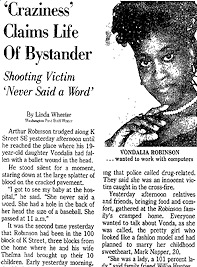 It turns me into an old codger to say it, but it's really true: those of you who didn't live in the DC area in the late 1980s and 1990s really have no concept of what Washington and its residents went through in those years. Even though large swaths of the city were considered "safe," with the bulk of the epidemic crime happening in certain neighborhoods, everyone was affected by the unrelenting drumbeat of murders and violence.
It turns me into an old codger to say it, but it's really true: those of you who didn't live in the DC area in the late 1980s and 1990s really have no concept of what Washington and its residents went through in those years. Even though large swaths of the city were considered "safe," with the bulk of the epidemic crime happening in certain neighborhoods, everyone was affected by the unrelenting drumbeat of murders and violence. 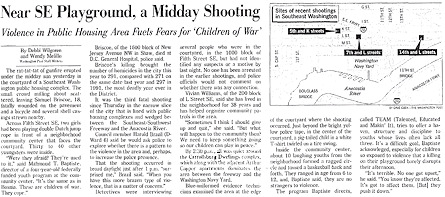
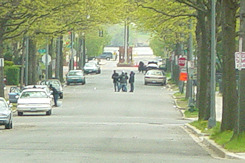 And yet the violence of the era probably fueled my interest in watching the city's redevelopment, to see neighborhoods that I had given up for lost in 1990 (such as Massachusetts Avenue east of Mt. Vernon Square) turn into luxury condo havens by the early 2000s. And it was why I began to watch--with no small sense of wonderment and even a little skepticism--as I started to hear in the late 1990s about the plans to "revitalize" the area south of the Southeast Freeway, an area that was a near-total No-Go for me from the time I moved to the south side of Capitol Hill in 1994 until my first furtive photographic forays by car in 2000 and 2003. (It's somewhat amazing now to realize that I did not actually put my feet on the ground at Third and K, SE, until the summer of 2005.)
And yet the violence of the era probably fueled my interest in watching the city's redevelopment, to see neighborhoods that I had given up for lost in 1990 (such as Massachusetts Avenue east of Mt. Vernon Square) turn into luxury condo havens by the early 2000s. And it was why I began to watch--with no small sense of wonderment and even a little skepticism--as I started to hear in the late 1990s about the plans to "revitalize" the area south of the Southeast Freeway, an area that was a near-total No-Go for me from the time I moved to the south side of Capitol Hill in 1994 until my first furtive photographic forays by car in 2000 and 2003. (It's somewhat amazing now to realize that I did not actually put my feet on the ground at Third and K, SE, until the summer of 2005.)
What you're looking at is a map of 64 violent deaths that occurred in Near Southeast between 1987 and 2004, when crack and other drugs and the accompanying violence nearly destroyed Washington, DC. And, if you go to the page itself, you will see the breakout of each death, with a name of the victim (when available), the date and location, and a brief thumbnail of what happened. The map and the data are interactive, so you can view just by year, or location, or type of death. It's not uplifting reading, but I really do recommend taking the time to go through it.
I can't pretend that this is a complete list; there are no online databases that easily offer up this data. I spent hours (and hours and hours) doing "grid searches" of the Washington Post and Washington Times electronic databases, having to search by street names and locations ("300 block of K street, SE; 300 block of L Street, SE; 3rd and K streets, SE; 1000 block of 3rd Street, SE;" etc. etc.). There's no guarantee that the newspapers mentioned every homicide, especially in the years when there were more than 400 murders across the city.
And, of course, this doesn't begin to capture the number of other crimes in the neighborhood during those years that didn't result in homicides--the robberies, the assaults, the non-fatal shootings and stabbings, etc.
It should be remembered that Near Southeast wasn't anywhere close to being the most dangerous area in the city; the 64 murders I've documented aren't even one percent of the 6,023 murders reported in this 18-year period (source: MPD, via the Internet Archive). So, as you look at this Near Southeast list, multiply it by 100 to imagine all the people who were killed in the city in those years.
 It turns me into an old codger to say it, but it's really true: those of you who didn't live in the DC area in the late 1980s and 1990s really have no concept of what Washington and its residents went through in those years. Even though large swaths of the city were considered "safe," with the bulk of the epidemic crime happening in certain neighborhoods, everyone was affected by the unrelenting drumbeat of murders and violence.
It turns me into an old codger to say it, but it's really true: those of you who didn't live in the DC area in the late 1980s and 1990s really have no concept of what Washington and its residents went through in those years. Even though large swaths of the city were considered "safe," with the bulk of the epidemic crime happening in certain neighborhoods, everyone was affected by the unrelenting drumbeat of murders and violence. Nights with seven murders in DC were unusual but not extraordinary; reading the paper each day with little more than tiny blurbs on most homicides (because they weren't really "news") made for a bleak landscape, even if you spent most of your time in sections of the city where day-to-day life seemed unaffected. DC's title of "Murder Capital of the World" was known far and wide, to the point that if you were traveling and told someone where you from, you'd often receive a sad shake of the head and hear, "It's such a shame what's happened to that lovely city."
It was a terrible time; and I say this as someone who was never affected by the violence personally in any way, other than knowing to avoid certain areas and be very careful during nights on the town. Looking back on it all now, through the lens of how far the city has come, makes the level of violence seem all the more incomprehensible and maddening. There's no question that I have become a little haunted over the past few weeks as I compiled this list, as my old generalized feelings of "quite a few people died on these streets over the years" have now been replaced with names, locations, a few photos, and gruesome details of executions and people in the wrong place at the wrong time.

 And yet the violence of the era probably fueled my interest in watching the city's redevelopment, to see neighborhoods that I had given up for lost in 1990 (such as Massachusetts Avenue east of Mt. Vernon Square) turn into luxury condo havens by the early 2000s. And it was why I began to watch--with no small sense of wonderment and even a little skepticism--as I started to hear in the late 1990s about the plans to "revitalize" the area south of the Southeast Freeway, an area that was a near-total No-Go for me from the time I moved to the south side of Capitol Hill in 1994 until my first furtive photographic forays by car in 2000 and 2003. (It's somewhat amazing now to realize that I did not actually put my feet on the ground at Third and K, SE, until the summer of 2005.)
And yet the violence of the era probably fueled my interest in watching the city's redevelopment, to see neighborhoods that I had given up for lost in 1990 (such as Massachusetts Avenue east of Mt. Vernon Square) turn into luxury condo havens by the early 2000s. And it was why I began to watch--with no small sense of wonderment and even a little skepticism--as I started to hear in the late 1990s about the plans to "revitalize" the area south of the Southeast Freeway, an area that was a near-total No-Go for me from the time I moved to the south side of Capitol Hill in 1994 until my first furtive photographic forays by car in 2000 and 2003. (It's somewhat amazing now to realize that I did not actually put my feet on the ground at Third and K, SE, until the summer of 2005.)I'll be writing in more detail in future entries about the violence in the Cappers, and at the Chapter III nightclub, but I wanted to post this overview first, to illustrate Near Southeast's descent to rock bottom for the people who might not be familiar with the recent history of the neighborhood, and also to remind everyone else of just what we as a city went through, as those memories become somewhat hazy in an era when some of the biggest battles are over funding for streetcars and dog parks. The city is certainly not without violence now, but the scale just doesn't compare.
And perhaps it'll also help clear up why I might not react with quite so much alarm when new residents write me concerned about a wave of auto thefts or other property crimes. I admit that it's somewhat unfair, but I think newcomers can talk to almost anyone who lived in Washington during the era of the Crack Wars and get the same reaction: You just have no idea.
UPDATE: Just to close the circle a bit, I should note that the reason I ended the dataset in 2004 is because, to the best of my knowledge, there have been no murders in Near Southeast since 21-year-old Terence Gathers died at Third and K on March 25 of that year.
|
Comments (0)
|
(This is just out from DDOT. I know *nothing* beyond this.) DDOT has announced today that they are launching multiple new parking pilot programs, to test out systems from a variety of vendors, that offer options such as pay-by-space and even sensors in parking spaces that can detect when a space is occupied or vacant.
For the area around Nationals Park, a company called ParkMobile will be offering a system where users, after signing up at the company's web site, can pay for parking via a cellphone or smartphone. (This system will also be in use for some spaces in Foggy Bottom and on Reservoir Road in Georgetown.)
This system--and three others that DDOT is evaluating--is expected to be in place by July 19, and will operate for 90 days, after which DDOT "will develop a long range strategy to upgrade its parking equipment and payment systems." It will be interesting to see if this helps cure some of the struggles with the current multispace meters, which do seem to be a bit balky (judging by the reports over the past few years in the DC Data Feeds).
More as I get it.
UPDATED to add the link to DDOT's press release, which gives more information on the other pilots in other sections of the city,
|
Comments (0)
More posts:
parking, Nationals Park
|

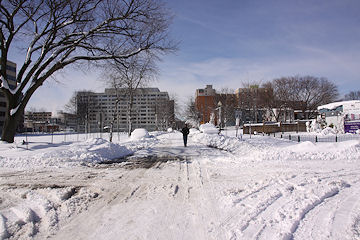


(These shots along Fourth Street--and more--are from February 7, 2010. There's plenty more that I never posted, because I got miffed that after spending about two hours trudging across the frozen tundra to get a pretty complete set of The Post-Blizzard Hood, we got smacked with the second one just a few days later, which made the snow in these shots look positively pedestrian.)
|
Comments (0)
More posts:
|
Via ANC 6B commissioner Norm Metzger, the Marines have sent out a one-page Comparison of Key Components chart, looking at the four possible sites for a new Marine barracks that appear to still be in the running (Square 882 is not on the chart, so this letter must have worked). There's not necessarily anything new in this table, but if you haven't slogged through the documents on the project's web site, it's a nice quick overview of the pros and cons (from the Marines' standpoint) of each location.
It does look like maybe they're looking at using their current Annex site at Seventh and L a little more intensely than it seemed in their early public workshops, with the possibility of expanding its footprint westward to Fifth Street, which would mean taking over the site where a new community center is to be built, and demolishing the parking garage built just east of Fifth in 2004. (But a new community center could be built as part of the "shared uses" scenario that the Marines are looking to enter into as part of their new plans to "create a win-win solution" for both the community and the USMC.) The baseball and soccer fields currently on the site would most likely be taken over in this scenario.
The Square 929/930 and 11th Street Exxon sites both would mean that the Virginia Avenue PARK AND Garden would have to be relocated, and though the document says that "replacement sites to be provided with goal of no net loss," the PARK AND garden's fans are fighting hard to not lose their current location.
The option of relocating the barracks to a site within the walls of the Navy Yard is also still on the table, though with the Navy talking about its own needs for an additional 700,000 square feet, it would seem difficult to reconcile the two expansion plans within the finite space of the WNY.
There probably won't be much news on the Barracks front until the "charrette" in September (details TBA), unless the Development Fairy makes a surprise appearance before then and finds a location that pleases all sides. For more background on the search up to now, read my previous entries.
(UPDATED to prevent hordes of Virginia Avenue Park fans from burning me in effigy for mistakenly referring only to the garden and not the entire park.)
|
Comments (0)
|
2412 Posts:
Go to Page: 1 | ... 24 | 25 | 26 | 27 | 28 | 29 | 30 | 31 | 32 ... 242
Search JDLand Blog Posts by Date or Category
Go to Page: 1 | ... 24 | 25 | 26 | 27 | 28 | 29 | 30 | 31 | 32 ... 242
Search JDLand Blog Posts by Date or Category



